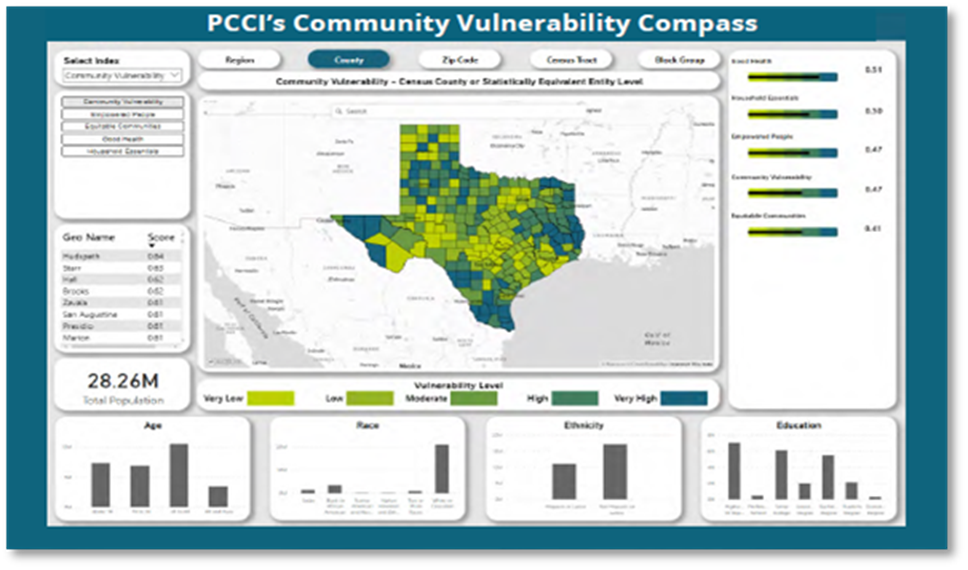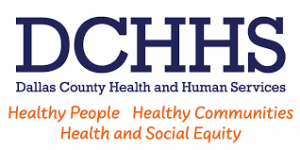
PCCI’s Community Vulnerability Compass
An interactive tool to navigate NMDOH-based needs of vulnerable populations
The CVC is a web-based tool enabling its users to visualize and more fully understand the context and complexities of the social barriers to health, access, and well-being of a community’s most vulnerable populations.
Based on the Healthy People 2030 framework seeking to achieve health equity, eliminate disparities, and promote good health for all, the CVC includes 26 clinical and socio-economic indicators clustered into four thematic domains denoting the health, resiliency, and economic vibrancy of neighborhoods.
Through a user-friendly dashboard, individuals can view which indexes, subindexes, and indicators are impacting vulnerability. They can utilize the dashboard’s dynamic online mapping feature, tabulated scores of indicators, and detailed analytics around other attributes that may affect vulnerability scores (e.g., race/ethnicity and demographics).

Key Features of the CVC
• Information can be visualized at the county, ZIP code, census tract, and block-group levels, giving users both a “forest and trees” view of a community. Intended to serve as a more detailed complement to other research studies (e.g., Community Health Needs Assessments) and field-based community voice initiatives, the CVC provides a comparable, data-driven summary of insights about community vulnerabilities.
• Users can also drill down to ask a series of follow-up “why” questions to really understand the root causes of inequities–a capability that is absent from other available tools.
• Insights provided by the CVC enable users to more effectively and efficiently prioritize, plan, and deploy–in a hyper localized way–supportive resources and interventions targeted to individuals or populations to advance whole-person health.
Vulnerable populations are groups of individuals (e.g., racial and ethnic minorities, the economically disadvantaged, those with chronic health conditions) who are at greater risk of poor health and well-being due to significant health and healthcare disparities (i.e., physical, economic, and social inequities). Their health and healthcare needs are most heavily driven by socio-economic, or Non Medical Drivers of Health (NMDOH), factors such as lack of education, language barriers, and difficulty in accessing care (e.g., transportation barriers, absence of internet connectivity, deficiency in insurance coverage). However, assessing, understanding, and addressing these NMDOH issues is not a simple or straightforward process for any organization seeking to improve the health of these residents. Specific unmet needs include:
• The need to look across NMDOH factors to gain a holistic picture. For individuals facing high vulnerability, rarely is there only one issue they are facing; they often have multiple, complex needs. In addition, language and cultural barriers, issues with health literacy, and the organization’s own lack of resources all work against obtaining this understanding (e.g., through individual interviews) for the required number of individuals and frequency needed for impact.
• The need for a shared language across communities. In addition, evidence continues to mount that an upstream, cross-sector approach to health can result in more positive, sustainable health outcomes. A broad, community-based approach focusing on societal conditions, disruption of structural barriers (e.g., cross-sector silos), and targeted risk-driven interventions for collective impact can more effectively and sustainably remove health inequities and transform a person’s quality of life and health outcomes. However, organizations across communities use disparate data sources and different measure sets, meaning there is a lack of standardization needed to efficiently build needed cross-sector networks, create a common starting point, and effectively evaluate progress over time.
• The need to have the means to conduct root cause analyses. While there are a number of publicly available indexes that measure vulnerability, there are few that enable the root cause analyses needed to effect lasting change (i.e., showing the specific NMDOH factors that are most impacting vulnerability in any given block group at any given time).
CVC addresses all of these needs and is rapidly becoming the go-to resource for teams addressing the needs of vulnerable populations.
CVC Is Built for both Clinical and Community-Based Organizations
The CVC can help virtually any organization (hospital system/health plan, care provider, CBO, public health entity, philanthropic funder, etc.) seeking to understand not only where its Community’s most vulnerable residents live but also many of the underlying, multi-dimensional root cause factors driving these residents’ poor health and healthcare access and ability to thrive. Through a fuller understanding of these root causes, organizations can develop better programs, resources, and interventions to eliminate disparities, achieve health equity, and improve the health and well-being of vulnerable residents.

CVC is an extremely useful tool for health systems and health plans who have made a commitment to community-based programming and need data-driven insights to support contemplated strategic objectives (e.g., new clinic locations). CVC insights can provide critical, contextualized information to guide these organizations and help them prioritize strategic imperatives.
CVC is especially useful for providers who have made commitments around addressing NMDOH. Given the Health Systems/Health Plans with increased focus on NMDOH difficulty in capturing this information directly from patients, the CVC can serve as a proxy to understand the block level of factors affecting individuals and their families. This information can also help providers design holistic programs to more effectively address the complex needs of their patients, particularly with respect to barriers to healthcare access. For example, grouping diabetic patients into diabetes program cohorts with other patients who have high degrees of similarity across clinical, personal, and behavioral characteristics can facilitate stronger provider-to-patient and patient-to-patient connections and support.
Delivering Impact
Organizations are successfully and innovatively leveraging the CVC to improve health and well-being across communities. Examples of current uses of CVC delivering impact include:
• In addition to a CBO’s use of CVC to identify areas of high vulnerability and root causes of needs across a community, the CBO is integrating its own outcome measures/goals (e.g., greater health insurance coverage across its region of service) into the CVC and tracking progress (through KPIs) over a multi-year timeframe.
• As part of an upstream, community-wide program to improve pediatric asthma in high-risk neighborhoods, organizational stakeholders are leveraging the CVC to identify rising risk for asthma-related Emergency Department (ED) visits/hospitalizations among low-income children with asthma.
CVC is also integrated into the design of a single, community-wide, data-driven surveillance system to track and monitor pediatric asthma at the community, neighborhood, and individual levels. This will improve the capacity of community stakeholders (including providers) to incorporate upstream, contextual NMDOH factors and other important data into local policies, programs, and interventions to prevent ED visits and hospitalizations, close the asthma disparity gap, and meaningfully evaluate the impact of these efforts on the long-term health outcomes, quality of life, and care experience of children with asthma (and their families).
• Through use of patient-specific data via electronic health records (EHR) and NMDOH data via the CVC (as a proxy for individual data), a health system is grouping patients by their access and utilization of healthcare resources rather than by disease group in order to more fully understand access barriers of patient cohorts and their utilization patterns. The goal is to improve patient healthcare access by supporting and informing better design of clinical programs that enable new community partnerships and enhanced models for patient engagement, such as expansion of virtual engagement options.
• A provider is using CVC NMDOH insights (e.g., transportation challenges, internet connectivity, access to vital services) to determine, among other things, optimal locations for new community clinics serving vulnerable populations with advanced healthcare access issues.
• A health system and health department are analyzing (via side-by-side dashboards) CVC NMDOH data and chronic disease data to better understand the specific NMDOH factors impacting disease prevalence and then design and drive improved care programs to that cohort.
Methods
The CVC Leverages Curated NMDOH Data to Create Normalized, Comparable Insights
While the ideal state is to hear about NMDOH challenges directly from the affected individuals, it isn’t feasible to obtain this information at scale across communities. However, through research we know that NMDOH factors are personalized to neighborhoods and this information can serve as a reasonable proxy for individual specifics, as characteristics of a resident’s block (e.g., transportation challenges, lack of green space) closely represent the challenges that resident likely faces.

The CVC groups levels of vulnerability for each of its four subindexes and 26 indicators into quintiles from lowest to highest vulnerability (i.e., very high, high, moderate, low, very low). Users can identify and create a visual map of where targeted individuals reside, study the characteristics of their neighborhoods and underlying barriers to health (ranked highest to lowest) based on location, and then prioritize individual or community-based service support. At the geographic level, the CVC captures data with increasing granularity from the county, ZIP code, census tract, to the block-group level. Users can view the 26 specific clinical and NMDOH factors clustered by theme across the four subindexes aligning with the Healthy People 2030 framework. The subindexes include Household Essentials (e.g., food insecurity, paycheck predictability, health insurance coverage), Empowered People (e.g., mobility, internet connectivity, education), Equitable Communities (e.g., employment, housing, green space), and Good Health (e.g., chronic diseases, life expectancy, mental health). The CVC provides a score (Community Vulnerability Index/CVI) based on vulnerability for each individual indicator, aggregated factors across each of the four CVC subindexes, and a “rolled-up” single score across the targeted geographic area.
For its users, the CVC also provides a standard, single source of accurate, in-depth, real-time data that they can access, understand, disseminate, and act upon to ensure the most effective, coordinated, evidence-driven programs and the best possible health outcomes. Through the CVC’s four subindexes and 26 clustered indicators, provider and community-support networks can have a common starting point from which to incorporate NMDOH factors and other important data into programs (e.g., reduction in pediatric asthma) that operate further upstream to close disparities gaps and advance health equity. And through a common evaluation framework, these networks can quantify the impact of interventions against the changing NMDOH dynamics across a community in both the short-term (e.g., reduction in readmissions) and in the longer-term improvements in health outcomes.
Depending on their specific use cases and programming, organizations need access to different levels of geographic specificity. The CVC allows users to view its subindexes (and the composite indicators) at the county, ZIP code, census tract, and block-group levels. This flexibility to zoom up or down, depending on the use cases, allows users to more effectively address their unique challenges, especially given their finite resources.
In collecting the data from multiple data sources for the CVC, PCCI goes through a rigorous cleansing and quality assurance (QA) process to ensure the input data is complete and more robust than what users would obtain from publicly available websites. For example, PCCI uses data-science approaches to fill in missing values (e.g., computing a score based on averaging the values of the three closest neighborhoods). We also make needed QA adjustments, such as excluding those of retirement age when calculating unemployment or including both rental- and mortgage-related expenses when calculating costs associated with housing. PCCI has also validated the CVC against the gold standard Area Deprivation Index (ADI) and the CDC’s Social Vulnerability Index (SVI) to ensure the CVC is directionally aligned with other commonly used sources. Although the ADI is a well-known, powerful tool in capturing community need across a number of factors, it does so in the aggregate and does not enable users to drill down to the level of specificity needed across individual factors to more effectively inform the best, most holistic program or intervention design. Conversely, other tools such as the SVI do allow users to drill down for specificity across included factors but those factors don’t encompass the broader CVC range of risk factors impacting a community’s health. For example, the SVI factors focus on the attributes relevant to its purpose in planning for public health emergencies. While the CVC and SVI include some common indicators, the CVC is specifically designed, through its alignment with the Healthy People 2030 framework, to focus on the wider range of specific, actionable neighborhood risk factors known to influence the health of vulnerable populations.
Finally, the CVC allows for integration—using the existing CVC dashboard—of a user’s existing data to create new, custom indexes or models. For example, if an organization is tracking particular metrics for readmissions reduction, those metrics can be integrated into the CVC and tracked over time along with the existing CVC subindexes/indicators.
###
To download a PDF of the CVC Information Sheet, use the following:






